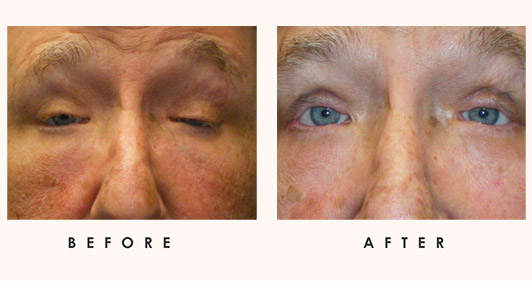Adult Tumors
Jump To
Introduction to Orbital Tumours
Noninvasive radiodiagnostic techniques such as ultrasonography (USG), computerized tomography (CT) and magnetic resonance imaging (MRI) helps those in the medical field diagnose tumors. Biopsy is justified only in rare cases of malignancy or in lymphomatous lesions to confirm the histological variety. About 20-25% of orbital disease are due to neoplasms and are commonly seen during and after the seventh decade of life. Malignant primary cancers of the orbit that call for a biopsy and radical surgery arise almost exclusively from the lacrimal gland.
Signs and Symptoms
Orbital tumors are suspected by the presence of following signs and symptoms:
- Proptosis or exophthalmos due to anterior displacement of the globe.
- Superior orbital tumors displace the globe inferiorly while masses in the inferior orbit displace the globe vertically.
- Globe motility is limited by simple mass effect, extraocular muscle involvement, involvement of nerves to extraocular muscles, and adhesions of tumor to the globe.
- Orbital pain, particularly in rapidly growing tumors.
- Increased retropulsion, which means increased resistance to digital pressure applied on the side of the tumor.
- Mass effect flattens the globe with changes in refractive power of the eye termed as a foreshortened globe.
- Pressure on sensory nerves resulting in periocular paraesthesia or anaesthesia.
- Proptosis causing droopy eye lid or ptosis.
- Palpable mass, when tumor is anteriorly placed.
- Visual field defect limited to affected eye only.
- Obstruction of venous outflow leading to lid edema.
- Papilledema results from mass effect on the retrobulbar optic nerve.
Benign and Malignant Diseases of the Orbit
Orbital tumors can be benign or malignant and arise mostly within the orbit or from an adjacent source, such as the eyelid, paranasal sinus or intracranial compartment. These tumors can be well-defined or diffuse and can be metastatic from distant sites. More detail is provided below:
- Well-defined Orbital Masses: Well-circumscribed lesions of the orbit include cavernous hemangioma, neurofibromas, schwannoma, hemangiopericytoma, meningioma, and gliomas. Cavernous hemangioma is the most common benign orbital tumor in adults, similar to capillary hemangioma in children. Patients present with painless proptosis that is gradually progressive with features of mass indenting the globe, striae in the retina and flattened globe on imaging studies. Surgical treatment for en masse removal is advocated.
- Mucocele: Also called mucopyocele, this is the most common cause of proptosis in children, and presents as a cystic, encapsulated mass that usually originates from the nasal sinuses (usually frontal sinus), following repeated bouts of sinusitis. Surgical drainage is considered only after treatment failure with a course of antibiotics, or in the presence of optic nerve compression.
- Diffuse Orbital Mass: These lesions usually require a biopsy to confirm the diagnosis. They include lymphoma, benign reactive lymphoid hyperplasia, orbital cellulitis, benign or malignant fibrous histiocytoma, neurofibromas, and sarcomas. Lymphomas are managed by radiation or chemotherapy, while pseudotumor is treated with steroids and ASA. Diffuse orbital masses requiring surgery include lymphangioma, fibrous histiocytoma, and neurofibroma.
- Thyroid Ophthalmopathy: Many orbital tumors present with proptosis or bulging of the eyeball, the most common cause being thyroid-related immune orbitopathy. There might or might not be laboratory derangements in thyroid function tests. Thyroid ophthalmopathy is four to five times more common in women, particularly in their perimenopausal phase. History of cigarette smoking might precede a more fulminant course. Pathogenesis of the disease is unclear leading to ambiguity in treatment protocols. Anterior segment eye complaints are treated with lubricants and topical steroids. Resultant glaucoma is managed with topical anti-glaucoma medications. Diplopia might need steroids and surgery while proptosis might require steroids, radiation or corrective surgery.
- Lacrimal Gland Tumors: They are easily diagnosed using ophthalmic B-scan at ultrasonography. More detailed analysis, particularly for bony involvement requires CT scans. Treatment comprises steroids, biopsy or excisional surgery.
- Bilateral Masses are either inflammatory lesions such as sarcoid/pseudotumour, or lymphomas. Inflammatory lesions constitute an overwhelming majority and are usually tender.
- Unilateral Masses are notorious and usually require a biopsy to rule out malignancy. Benign mixed tumors are painless, gradually progressive masses of the lacrimal gland causing inferior displacement of the globe among patients in their third and fourth decades of life. They are treated by surgical excision of the mass within its pseudocapsule.
- Adenoid Cystic Carcinoma is the most common malignant epithelial tumor of the lacrimal gland and presents similar to a benign mixed tumor. However, there is pain, numbness, diplopia and visual disturbance and a circumscribed lacrimal gland mass with blurred margins infiltrating into bone on CT scan. Treatment is surgical. They might recur years later but with a mortality of 90%.
- Pleomorphic Adenocarcinomas are highly aggressive, malignant mixed tumors seen in patients in their fifth and sixth decades of life. It is the second most common malignant tumor of the lacrimal gland and presents as a painless mass with or without new increase in size. They usually have a history of prior biopsy for a benign mixed tumor which has undergone malignant transformation. Treatment is surgical but more than 75% of the patients die of metastases within 5 years.
- Lymphoid Masses: Lymphomas require careful pathologic analysis aided by fresh tissue with appropriate marker studies and systemic staging, which help to define the disease and guide treatment with chemotherapy alone, local radiation alone, or a combination of both. Bilateral orbital involvement indicates a poorer prognosis.
- Bone Lesions of the Orbit: CT scan provides the best delineation of bony lesions causing proptosis.
- Primary Bony Lesions: Osteomas, osteogenic sarcoma, and fibrous dysplasia.
- Secondary Bony Lesions: Metastases from prostate, thyroid, lung, breast, kidney, and the non-metastatic eosinophilic granuloma, otherwise known as histiocytosis X spectrum



